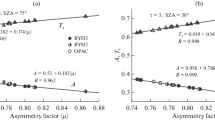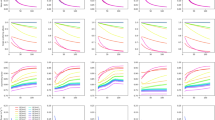Abstract
The results of statistical simulation of intensity of transmitted solar radiation in the presence of optically thin cirrus clouds for two sensing geometries: in solar almucantar and hybrid scan (AERONET photometric network) are considered. Numerical experiments were performed using ice crystal cloud models: OPAC (hexagonal particles with a smooth surface) and a model proposed by Baum et al. (а mixture of particles with different shapes, hexagonal columns and aggregates of hexagonal columns with a very rough surface). The effects of shape and size of ice crystals on the angular distributions of downward radiation in the wavelength channels of 440 and 870 nm are estimated for background atmospheric situations observed in Tomsk in the summer period.





Similar content being viewed by others
REFERENCES
B. N. Holben, T. F. Eck, I. Slutsker, D. Tanre, J. P. Buis, A. Setzer, E. Vermore, J. A. Reagan, Y. J. Kaufman, T. Nakajima, F. Lavenu, I. Jankowiak, and A. Smirnov, “AERONET—a federal instrument network and data archive for aerosol characterization,” Remote Sens. Environ. 66 (1), 1–16 (1998).
A. M. Sayer, N. C. Hsu, J. Lee, W. V. Kim, and S. T. Dutcher, “Validation, stability, and consistency of MODIS Collection 6.1 and VIIRS Version 1 deep blue aerosol data over land,” J. Geophys. Res.: Atmos. 124 (8), 4658–4688 (2019).
R. C. Levy, L. A. Munchak, S. Mattoo, F. Patadia, L. A. Reme, and R. E. Holz, “Towards a long-term global aerosol optical depth record: Applying a consistent aerosol retrieval algorithm to MODIS and VIIRS-observed reflectance,” Atmos. Meas. Tech. 8, 4083–4110 (2015).
L. A. Remer, Y. J. Kaufman, D. Tanre, S. Mattoo, D. A. Chu, J. V. Martins, R. Li, C. Ichoku, R. C. Levy, R. G. Kleidman, T. F. Eck, E. Vermote, and B. N. Holben, “The MODIS aerosol algorithm, products, and validation,” J. Atmos. Sci. 62 (4), 947–973 (2005).
T. Holzer-Popp, G. de Leeuw, J. Griesfeller, D. Martynenko, L. Kluser, S. Bevan, W. Davies, F. Ducos, J. L. Deuze, R. G. Graigner, A. Heckel, W. von Hoyningen-Hune, P. Kolmonen, P. Litvinov, P. North, C. A. Poulsen, D. Ramon, R. Siddans, L. Sogacheva, D. Tanre, G. E. Thomas, M. Vountas, J. Descloitres, J. Griesfeller, S. Kinne, M. Schulz, and S. Pinnock, “Aerosol retrieval experiments in the ESA Aerosol_cci project,” Atmos. Meas. Tech. 6, 1919–1957 (2013).
H. Jethva, O. Torres, and C. Ahn, “Global assessment of OMI aerosol single-scattering albedo using ground-based AERONET inversion,” J. Geophys. Res.: Atmos. 119 (14), 9020–9040 (2014).
S. V. Afonin, V. V. Belov, B. D. Belan, M. V. Panchenko, S. M. Sakerin, and D. M. Kabanov, “Comparison of satellite (AVHRR/NOAA) and ground-based measurements of atmospheric aerosol characteristics,” Atmos. Ocean. Opt. 15 (12), 1015–1019 (2002).
S. V. Afonin, V. V. Belov, M. V. Panchenko, S. M. Sakerin, and M. V. Engel’, “Correlation analysis of spatial fields of the aerosol optical thickness on the base of MODIS data,” Atmos. Ocean. Opt. 21 (6), 443–447 (2008).
O. E. Garcıa, A. M. Dıaz, F. J. Exposito, J. P. Dıaz, O. Dubovik, P. Dubuisson, J.-C. Roger, T. F. Eck, A. Sinyuk, Y. Derimian, E. G. Dutton, J. S. Schafer, B. N. Holben, and C. A. Garcıa, “Validation of AERON-ET estimates of atmospheric solar fluxes and aerosol radiative forcing by ground-based broadband measurements,” J. Geophys. Res. 113 (D21207) (2008). https://doi.org/10.1029/2008JD010211
O. E. Garcıa, J. P. Dıaz, F. J. Exposito, A. M. Dıaz, O. Dubovik, Y. Derimian, P. Dubuisson, and J.‑C. Roger, “Shortwave radiative forcing and efficiency of key aerosol types using AERONET data,” Atmos. Chem. Phys. 12, 5129–5145 (2012).
T. B. Zhuravleva, D. M. Kabanov, I. M. Nasrtdinov, T. V. Russkova, S. M. Sakerin, A. Smirnov, and B. N. Holben, “Radiative characteristics of aerosol during extreme fire event over Siberia in summer 2012,” Atmos. Meas. Tech 10, 179–198 (2017).
Y. Derimian, O. Dubovik, X. Huang, T. Lapyonok, P. Litvinov, A. B. Kostinski, P. Dubuisson, and F. Ducos, “Comprehensive tool for calculation of radiative fluxes: Illustration of shortwave aerosol radiative effect sensitivities to the details in aerosol and underlying surface characteristics,” Atmos. Chem. Phys. 16, 5763–5780 (2016).
J. Lee, J. Kim, C. Song, S. Kim, Y. Chun, B. Sohn, and B. Holben, “Characteristics of aerosol types from AERONET sunphotometer measurements,” Atmos. Environ. 44, 3110–3117 (2010).
P. B. Russell, R. W. Bergstrom, Y. Shinozuka, A. D. Clarke, P. F. DeCarlo, J. L. Jimenez, J. M. Livingston, J. Redemann, O. Dubovik, and A. Strawa, “Absorption Angstrom exponent in AERONET and related data as an indicator of aerosol composition,” Atmos. Chem. Phys. 10, 1155–1169 (2010).
D. M. Giles, B. N. Holben, T. F. Eck, A. Sinyuk, A. Smirnov, I. Slutsker, R. Dickerson, A. Thompson, and J. Schafer, “An analysis of AERONET aerosol absorption properties and classifications representative of aerosol source regions,” J. Geophys. Res. 117 (D17203) (2012).
S.-K. Shin, M. Tesche, Y. Noh, and D. Muller, “Aerosol-type classification based on AERONET Version 3 inversion products,” Atmos. Meas. Tech 12, 3789–3803 (2019).
O. Dubovik and M. King, “A flexible inversion algorithm for retrieval of aerosol optical properties from sun and sky radiance measurements,” J. Geophys. Res. 105 (D16), 20673–20696 (2000).
O. Dubovik, A. Sinyuk, T. Lapyonok, B. N. Holben, M. Mishchenko, P. Yang, T. F. Eck, H. Volten, O. Munoz, B. Veihelmann, W. J. van der Zande, J. F. Leon, M. Sorokin, and I. Slutsker, “Application of spheroid models to account for aerosol particle nonsphericity in remote sensing of desert dust,” J. Geophys. Res. 111 (D11208) (2006). https://doi.org/10.1029/2005JD006619
A. Sinyuk, B. N. Holben, T. F. Eck, D. M. Giles, I. Slutsker, S. Korkin, J. S. Schafer, A. Smirnov, M. Sorokin, and A. Lyapustin, “The AERONET Version 3 aerosol retrieval algorithm, associated uncertainties and comparisons to Version 2,” Atmos. Meas. Tech. 13, 3375–3411 (2020).
B. N. Holben, T. F. Eck, I. Slutsker, A. Smirnov, A. Sinyuk, J. Schafer, D. Giles, and O. Dubovik, “AERONET’s Version 2.0 quality assurance criteria,” Proc. SPIE—Int. Soc. Opt. Eng. 6408 (2006). https://doi.org/10.1117/12.706524
A. Smirnov, T. B. Zhuravleva, M. Segal-Rosenheimer, and B. N. Holben, “Limitations of AERONET SDA product in presence of cirrus clouds,” J. Quant. Spectrosc. Radiat. Transf. 206, 338–341 (2018).
D. P. Wylie, D. L. Jackson, W. P. Menzel, and J. J. Bates, “Trends in global cloud cover in two decades of HIRS observations,” J. Clim. 18 (15), 3021–3031 (2005).
K. Sassen, Z. Wang, and D. Liu, “Global distribution of cirrus clouds from CloudSat/Cloud-Aerosol Lidar and Infrared Pathfinder Satellite Observations (CALIPSO) measurements,” J. Geophys. Res. D 113 (2008). https://doi.org/10.1029/2008JD009972
I. P. Mazin and S. M. Shmeter, Clouds. Structure and Physics of Formation (Gidrometeoizdat, Leningrad, 1983) [in Russian].
B. A. Baum, A. J. Heymsfield, P. Yang, and S. T. Bedka, “Bulk scattering models for the remote sensing of ice clouds. Part 1: Microphysical data and models,” J. Appl. Meteorol. 44 (2005).
A. J. Heymsfield, C. Schmitt, and A. Bansemer, “Ice cloud particle size distributions and pressure dependent terminal velocities from in situ observations at temperatures from 0° to –86°C,” J. Atmos. Sci. 70, 4123–4154 (2013).
A. M. Fridlind, R. Atlas, B. van Diedenhoven, J. Um, G. M. McFarquhar, A. S. Ackerman, E. J. Moyer, and R. P. Lawso, “Derivation of physical and optical properties of mid-latitude cirrus ice crystals for a size-resolved cloud microphysics model,” Atmos. Chem. Phys. 16, 7251–7283 (2016).
E. Kienast-Sjogren, C. Rolf, P. Seifert, U. K. Krieger, B. P. Luo, M. Kramer, and T. Peter, “Climatological and radiative properties of midlatitude cirrus clouds derived by automatic evaluation of lidar measurements,” Atmos. Chem. Phys. 16, 7605–7621 (2016).
M. Hess, P. Koepke, and I. Schult, “Optical properties of aerosols and clouds: The software package OPAC,” Bull. Am. Meteorol. Soc. 79, 831–844 (1998).
B. A. Baum, P. Yang, A. J. Heymsfield, S. Platnick, M. D. King, Y.-X. Hu, and S. T. Bedka, “Bulk scattering properties for the remote sensing of ice clouds. Part II: Narrowband models,” J. Appl. Meteorol. 44 (12), 1896–1911 (2005).
B. A. Baum, P. Yang, A. J. Heymsfield, C. G. Schmitt, Y. Xie, A. Bansemer, Y. X. Hu, and Z. Zhang, “Improvements in shortwave bulk scattering and absorption models for the remote sensing of ice clouds,” J. Appl. Meteorol. Clim 50 (5), 1037–1056 (2011).
B. A. Baum, P. Yang, A. J. Heymsfield, A. Bansemer, A. Merrelli, C. Schmitt, and C. Wang, “Ice cloud bulk single-scattering property models with the full phase matrix at wavelengths from 0.2 to 100 µm,” J. Quant. Spectrosc. Radiant. Transfer. 146, 123–139 (2014).
T. B. Zhuravleva, ”Simulation of solar radiative transfer under different atmospheric conditions. Part I. The deterministic atmosphere,” Atmos. Ocean. Opt. 21 (2), 81–95 (2008).
T. B. Zhuravleva, I. M. Nasrtdinov, T. V. Russkova, and T. Yu. Chesnokova, “Mathematical simulation of brightness fields in broken clouds for observations from Earth’s surface and from space in plane and spherical atmospheric models,” Proc. SPIE—Int. Soc. Opt. Eng. 10035, 1003502 (2016).
M. A. Nazaraliev, Statistical Simulation of Radiation Processes in the Atmosphere (Nauka, Novosibirsk, 1990) [in Russian].
F. X. Kneizys, D. S. Robertson, L. W. Abreu, P. Acharya, G. P. Anderson, L. S. Rothman, J. H. Chetwynd, J. E. A. Selby, E. P. Shetle, W. O. Gallery, A. Berk, S. A. Clough, and L. S. Bernstein, The MODTRAN 2/3 report and LOWTRAN 7 Model (Phillips Laboratory, Geophysics Directorate, Hanscom AFB, MA 01731-3010, 1996).
S. J. Hook, ASTER Spectral Library: Johns Hopkins University (JHU) spectral library; Jet Propulsion Laboratory (JPL) spectral library; The United States Geological Survey (USGS-Reston) spectral library [Electron resource] (1998). Dedicated CD-ROM. Version 1.2.
M. Shiobara and S. Asano, “Estimation of cirrus optical thickness from sun-photometer measurements,” J. Appl. Meteorol. 33 (6), 672–681 (1994).
M. Segal-Rosenheimer, P. B. Russell, J. M. Livingston, S. Ramachandran, J. Redemann, and B. A. Baum, “Retrieval of cirrus properties by sun photometry: A new perspective on an old issue,” J. Geophys. Res.: Atmos. 118, 4503–4520 (2013).
ACKNOWLEDGMENTS
In this work, measurements performed at Tomsk and Tomsk-22 AERONET sites have been used; the author thanks B. Holben, M. V. Panchenko, and S. M. Sakerin for organizing and carrying out these observations. The author also thanks organizers of websites http://stc-se.com/data/ bbaum/Ice_Models/index.html and http://aeronet.gsfc. nasa.gov for compiling the information and providing the possibility of its free use. The content of the work was discussed with A. Smirnov (GSFC/NASA), whose valuable advice and recommendations are sincerely acknowledged.
Funding
A modification of the statistical simulation algorithm of solar radiative transfer in ice crystal clouds and preparation of input parameters were performed within the State Assignment of the Institute of Atmospheric Optics, Siberian Branch, Russian Academy of Sciences; numerical experiments and analysis of results were supported by the Russian Foundation for Basic Research (grant no. 19-01-00351).
Author information
Authors and Affiliations
Corresponding author
Ethics declarations
The authors declare that they have no conflicts of interest.
Additional information
Translated by O. Bazhenov
Rights and permissions
About this article
Cite this article
Zhuravleva, T.B. Effect of Shape and Sizes of Crystal Particles on Angular Distributions of Transmitted Solar Radiation in Two Sensing Geometries: Results of Numerical Simulation. Atmos Ocean Opt 34, 50–60 (2021). https://doi.org/10.1134/S1024856021010127
Received:
Revised:
Accepted:
Published:
Issue Date:
DOI: https://doi.org/10.1134/S1024856021010127




